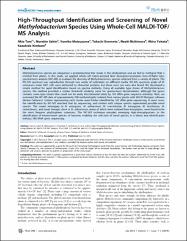High-Throughput Identification and Screening of Novel Methylobacterium Species Using Whole-Cell MALDI-TOF/MS Analysis

View/
Date
2012Author
Tani, AkioŞahin, Nurettin
Matsuyama, Yumiko
Enomoto, Takashi
Nishimura, Naoki
Yokota, Akira
Kimbara, Kazuhide
Metadata
Show full item recordAbstract
Methylobacterium species are ubiquitous alpha-proteobacteria that reside in the phyllosphere and are fed by methanol that is emitted from plants. In this study, we applied whole-cell matrix-assisted laser desorption/ionization time-of-flight mass spectrometry analysis (WC-MS) to evaluate the diversity of Methylobacterium species collected from a variety of plants. The WC-MS spectrum was reproducible through two weeks of cultivation on different media. WC-MS spectrum peaks of M. extorquens strain AM1 cells were attributed to ribosomal proteins, but those were not were also found. We developed a simple method for rapid identification based on spectra similarity. Using all available type strains of Methylobacterium species, the method provided a certain threshold similarity value for species-level discrimination, although the genus contains some type strains that could not be easily discriminated solely by 16S rRNA gene sequence similarity. Next, we evaluated the WC-MS data of approximately 200 methylotrophs isolated from various plants with MALDI Biotyper software (Bruker Daltonics). Isolates representing each cluster were further identified by 16S rRNA gene sequencing. In most cases, the identification by WC-MS matched that by sequencing, and isolates with unique spectra represented possible novel species. The strains belonging to M. extorquens, M. adhaesivum, M. marchantiae, M. komagatae, M. brachiatum, M. radiotolerans, and novel lineages close to M. adhaesivum, many of which were isolated from bryophytes, were found to be the most frequent phyllospheric colonizers. The WC-MS technique provides emerging high-throughputness in the identification of known/novel species of bacteria, enabling the selection of novel species in a library and identification without 16S rRNA gene sequencing.

















